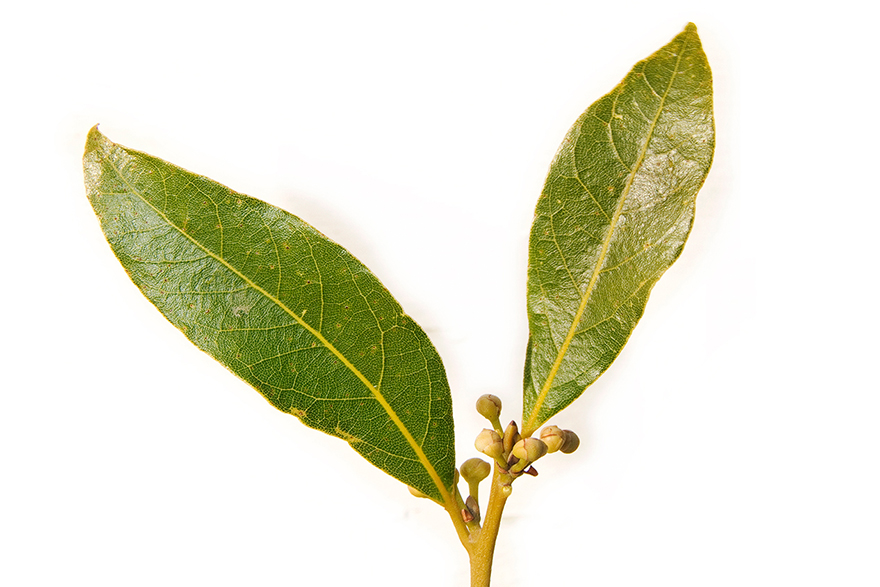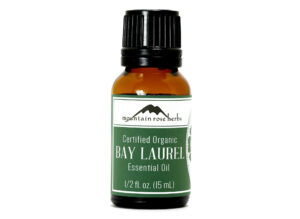Bay Laurel Essential Oil
Anecdotal Folklore of the Benefits of Bay Leaf
Tracing the Bay Laurel species, Laurel Nobilis L., into the 1600’s, Bay Leaf was used for warding off all negative witchcraft and evil. Laurel wreaths were traditionally worn by esteemed leaders to keep them safe from evil and harm. Warriors and athletes were valued and protected with Bay Laurel.
As a ceremonial sign of their deep love and promise of fidelity, couples were known to split a bay leaf using half for each lover to keep in remembrance of their devotion and plans to reunite.
Bay Laurel continued to be used throughout centuries, believed to keep out unwanted visitors, their footprints were swept from the doorstep, then scrubbed with bay leaves to prevent their return. In modern times, these efforts to prevent “unwanted guests” like insects are successfully thwarted with the use of bay leaves and their essential oils kept in storage containers with foods like grains and rice.
The essential oils extracted fro Laurus nobilis, bay leaf, are studied in a broth micro-dilution process to determine the antibacterial activities against 5 particular bacterial strains. The essential oils extracted from Laurus nobilis L., bay leaf, are introduced to the following strains to examine the effects:
- Staphylococcus aureus ATCC 25923
- Staphylococcus epidermis CIP 444
- Pseudomonas aeruginso ATCC 27853
- Escherichia Coli ATCC 35218
- Enterococcus faecalis ATCC 29212
The study results show promising antibacterial capabilities that have useful medical and nutritional applications.(1)
History of the Medicinal Use of Bay Leaf
Bay Leaf is a diocecious culinary and medicinal herb used for it’s healing and pain reducing properties. Leaves taken from this evergreen tree or shrub were first found in the southern Mediterranean area. These trees reach 60 feet or more in height when growing in their preferred habitat, which is rocky and in well-drained soil.
Early Ethnobotany
Dioscorides, a physician ad botanist of 1st Century AD., Greece, first used Bay Leaf to fortify the liver and kidneys. The cleansing and fortification properties of bay leaf worked to improve the health of the stomach and bladder. As a natural pain reliever, treatment as a salve for bee sting pain, skin disorders, as well as uterine problems, but not for internal use.
The leaves and berries of the Laurel nobilis L. plant became very popular for use in treating disorders of the digestive tract, to stimulate the appetite, and improve digestion.
Methods for applying bay leaf were also developed in bath soaks, essential massaging oils, and in creams or slaves like the “soldiers’ ointment” for skin ailments, aches, pain, arthritic pain, and even to promote the onset of menstruation.
Buy Organic Bay Laurel Essential Oil
Our organic bay leaf essential oil is a middle note steam distilled from Laurus nobilis. It can be described as having a somewhat ‘medicinal’ aroma and shares qualities with oils like eucalyptus and tea tree for its intense and refreshing camphoraceous scent. Bay laurel oil is often used in diffuser blends for its ability to cleanse the air and encourage deep breathing.
Laurus nobilis is native to the Mediterranean and has long been a symbol of prosperity, intellect, cleansing, and divination. The sturdy evergreen leaves are woven into wreaths or crowns and have long been a symbol of success in academia and the arts.
Aroma
This complex aroma has fresh and herbal camphoraceous notes that are layered with sweetness and spice.
Constituents
This oil contains 1,8-cineole, α-pinene, α-terpinyl acetate, and linalool.
You will find 1,8-cineole in eucalyptus, cajeput, and sage. α-Pinene is found in many oils such as myrtle, cistus, angelica root, and Scotch pine. α-Terpinyl acetate appears in cypress, and cardamom. Linalool is found in ho wood, lavender tea tree, neroli, and spike lavender.
Blending and Uses
Bay leaf and Roman chamomile are a beautiful aromatic pair for roll-on aromatherapy or linen mist while unwinding at the end of your day. Use bay leaf oil in your diffuser to create an uplifting and protected space. Add lavender, cinnamon leaf, or lemon to enhance these comforting qualities. Blend into homemade cleaning recipes with cedar, pine, or lime oils for surface spray, scrubs, or laundry soap.
Add to massage oils and blends for occasional soreness with ylang ylang, eucalyptus, ginger, or marjoram. Use bay oil in toning facial sprays for normal to oily skin types mixed with sage or bergamot oils and witch hazel.
This oil can be used around the home to deter pests with its strong aroma or added to outdoor sprays with cedar, lavender, and citronella.
Packaging
1/2 oz. and 1 oz. essential oils are packaged in amber glass bottles with drop reducers for easy application. Larger sizes are packaged in amber screw cap bottles and do not come with reducers or droppers.
Safety
This oil can cause breathing problems in young children. It is potentially carcinogenic, can cause skin sensitization and mucous membrane irritation. Never use essential oils undiluted, in eyes or mucus membranes. Do not take internally unless working with a qualified healthcare practitioner. Keep away from children and pets.
Before using perform a small patch test on your inner forearm or back. Apply a small quantity of diluted essential oil and cover with a bandage. If you experience any irritation use carrier oil or cream to further dilute the essential oil, and then wash with soap and water. If no irritation occurs after 48 hours it is safe to use on your skin.


